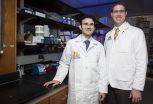(Press-News.org) All bird migrations are fraught with danger – from the risk of not finding enough food, to facing stormy weather, and most importantly – trying not to be eaten along the way. Raptors such as peregrine falcons (see picture) are the main predators of migratory birds, and huge flocks of congregating shorebirds can be easy pickings. In a paper, just published in Animal Migration, an open access journal by De Gruyter Open, Dr. Sarah Jamieson and her colleagues provide new evidence that shorebird species can adopt substantially different ways of dealing with this predation pressure.
It turns out that some species simply avoid the periods when peregrines are around, by staying longer at breeding grounds, and migrate only when the coast is clear. Others appear to make a run for it before the peregrines start migrating themselves. And, according to the article – those early-migrating species are capable of timing their breeding activities just spot-on, so that they can leave each year exactly when they need to.
The paper shows that in the years when peregrine migration begins early, the early-migrators appear to cut short their breeding activities, presumably to beat the onrush of raptors. Meanwhile, those species that migrate later do not need to shorten their nesting season. "This paper emphasizes the inherent conflict all migratory birds face between trying to produce as many offspring as possible while still maximizing their own survival" says Andy Davis, Editor-in-Chief of the journal.
According to Dr. Wesley Hochatchka, Assistant Director of Bird Population Studies at the Cornell Lab of Ornithology, "the behavior of one shorebird species, the Western Sandpiper, might appear counter-intuitive at first: why would parents end their care of offspring earlier in a year when weather was allowing for especially prolonged breeding season? This paper shows a complex decision process in which adult sandpipers are attempting to minimize their own risk of predation on migration, even if it means potentially limiting the amount of care to their own offspring."
INFORMATION:
The original article is available fully open access to read, download and share on: http://www.degruyter.com/view/j/ami.2014.2.issue-1/ami-2014-0004/ami-2014-0004.xml?format=INT
Natural selection causes early migration and shorter parental care for shorebirds
New study shows migratory shorebirds have different ways of dealing with raptor predation
2014-09-25
ELSE PRESS RELEASES FROM THIS DATE:
Spot on against autoimmune diseases and chronic inflammations
2014-09-25
This news release is available in German.
The immune system functions as the body's police force, protecting it from intruders like bacteria and viruses. However, in order to ascertain what is happening in the cell it requires information on the foreign invaders. This task is assumed by so-called immunoproteasomes. These are cylindrical protein complexes that break down the protein structures of the intruders into fragments that can be used by the defense system.
"In autoimmune disorders like rheumatism, type 1 diabetes or multiple sclerosis as well as severe ...
Discovery may lead to better treatments for autoimmune diseases, bone loss
2014-09-25
Scientists have developed an approach to creating treatments for osteoporosis and autoimmune diseases that may avoid the risk of infection and cancer posed by some current medications.
Researchers at Washington University School of Medicine in St. Louis redesigned a molecule that controls immune cell activity, changing the molecule's target and altering the effects of the signal it sends.
Current treatments for bone loss and autoimmune disorders block these molecules and their signals indiscriminately, which over time increases the risk of infections and cancer. The ...
Fossil of multicellular life moves evolutionary needle back 60 million years
2014-09-25
A Virginia Tech geobiologist with collaborators from the Chinese Academy of Sciences have found evidence in the fossil record that complex multicellularity appeared in living things about 600 million years ago – nearly 60 million years before skeletal animals appeared during a huge growth spurt of new life on Earth known as the Cambrian Explosion.
The discovery published online Wednesday in the journal Nature contradicts several longstanding interpretations of multicellular fossils from at least 600 million years ago.
"This opens up a new door for us to shine some light ...
NCI/FDA lung cancer workshop leads to the innovatively designed clinical trials
2014-09-25
DENVER – The recent launch of two clinical trials offer innovative study designs for patients with lung cancer. These clinical trials are the direct result of a National Cancer Institute (NCI) sponsored workshop chaired by Drs. Fred R. Hirsch, Shakun Malik and Claudio Dansky- Ullman, that brought together the NCI Thoracic Malignancies Steering Committee, the US Food and Drug Administration (FDA), academicians, clinicians as well as industry and government stakeholders to discuss issues and challenges related to clinical trial design and biomarkers for lung cancer targeted-therapies.
The ...
Treatment studied to help patients 'burned to the bone'
2014-09-25
An anti-inflammatory treatment, studied in the labs of regenerative medicine specialists and trauma surgeons, may prevent what's become one of the war-defining injuries for today's troops.
Those burned by high-velocity explosive devices are at-risk for heterotopic ossification (HO), in which bone develops in places it shouldn't be, outside the skeleton, in joints, muscles and tendons. The painful condition can make it difficult to move and function and commonly affects patients who suffer burns, automobile accidents, orthopedic surgery and blast injuries and other combat ...
Live long and phosphor: Blue LED breakthrough for efficient electronics
2014-09-25
ANN ARBOR—In a step that could lead to longer battery life in smartphones and lower power consumption for large-screen televisions, researchers at the University of Michigan have extended the lifetime of blue organic light emitting diodes by a factor of 10.
Blue OLEDs are one of a trio of colors used in OLED displays such as smartphone screens and high-end TVs. The improvement means that the efficiencies of blue OLEDs in these devices could jump from about 5 percent to 20 percent or better in the near future.
OLEDs are the latest and greatest in television technology, ...
Study finds global sea levels rose up to 5 meters per century at the end of the last 5 ice age
2014-09-25
Land-ice decay at the end of the last five ice-ages caused global sea-levels to rise at rates of up to 5.5 metres per century, according to a new study.
An international team of researchers developed a 500,000-year record of sea-level variability, to provide the first account of how quickly sea-level changed during the last five ice-age cycles.
The results, published in the latest issue of Nature Communications, also found that more than 100 smaller events of sea-level rise took place in between the five major events.
Dr Katharine Grant, from the Australian National ...
Calming down immune cells could hold key to melanoma treatment
2014-09-25
Immune cells may be responsible for drug resistance in melanoma patients, according to research published in Cancer Discovery.
Cancer Research UK scientists at The University of Manchester found that chemical signals produced by a type of immune cell, called macrophages, also act as a survival signal for melanoma cells.
When the researchers blocked the macrophages' ability to make this signal - called TNF alpha - melanoma tumours were much smaller and easier to treat.
When melanoma patients are given chemotherapy or radiotherapy it causes inflammation, increasing ...
Interactive website helps lower-income smokers to stop smoking
2014-09-25
People with lower incomes attempting to quit smoking are 36% more likely to succeed if they use a new interactive website called 'StopAdvisor' than if they use a static information website, finds a randomised controlled trial led by UCL researchers. The trial was funded by the National Prevention Research Initiative, a consortium of 16 UK health research funders.
A total of 4,613 smokers took part in the study, of whom 2,142 were classified into a 'lower income' group who had never worked, were long term unemployed or from routine or manual occupations (lower socioeconomic ...
Skirt size increase linked to 33 percent greater postmenopausal breast cancer risk
2014-09-25
Overall weight gain during adulthood is known to be a risk factor for breast cancer, but a thickening waist seems to be particularly harmful, indicating the importance of staving off a midriff bulge, the research shows.
The researchers base their findings on almost 93,000 women taking part in the UK Collaborative Trial of Ovarian Cancer Screening (UKCTOCS) in England.
The women were all aged over 50, had gone through the menopause, and had no known breast cancer when they entered the study between 2005 and 2010.
At enrolment they provided detailed information on height ...
LAST 30 PRESS RELEASES:
Exposure to natural light improves metabolic health
As we age, immune cells protect the spinal cord
New expert guidance urges caution before surgery for patients with treatment-resistant constipation
Solar hydrogen can now be produced efficiently without the scarce metal platinum
Sleeping in on weekends may help boost teens’ mental health
Study: Teens use cellphones for an hour a day at school
After more than two years of war, Palestinian children are hungry, denied education and “like the living dead”
The untold story of life with Prader-Willi syndrome - according to the siblings who live it
How the parasite that ‘gave up sex’ found more hosts – and why its victory won’t last
When is it time to jump? The boiling frog problem of AI use in physics education
Twitter data reveals partisan divide in understanding why pollen season's getting worse
AI is quick but risky for updating old software
Revolutionizing biosecurity: new multi-omics framework to transform invasive species management
From ancient herb to modern medicine: new review unveils the multi-targeted healing potential of Borago officinalis
Building a global scientific community: Biological Diversity Journal announces dual recruitment of Editorial Board and Youth Editorial Board members
Microbes that break down antibiotics help protect ecosystems under drug pollution
Smart biochar that remembers pollutants offers a new way to clean water and recycle biomass
Rice genes matter more than domestication in shaping plant microbiomes
Ticking time bomb: Some farmers report as many as 70 tick encounters over a 6-month period
Turning garden and crop waste into plastics
Scientists discover ‘platypus galaxies’ in the early universe
Seeing thyroid cancer in a new light: when AI meets label-free imaging in the operating room
Neutrophil-to-lymphocyte ratio may aid risk stratification in depressive disorder
2026 Seismological Society of America Annual Meeting
AI-powered ECG analysis offers promising path for early detection of chronic obstructive pulmonary disease, says Mount Sinai researchers
GIMM uncovers flaws in lab-grown heart cells and paves the way for improved treatments
Cracking the evolutionary code of sleep
Medications could help the aging brain cope with surgery, memory impairment
Back pain linked to worse sleep years later in men over 65, according to study
CDC urges ‘shared decision-making’ on some childhood vaccines; many unclear about what that means
[Press-News.org] Natural selection causes early migration and shorter parental care for shorebirdsNew study shows migratory shorebirds have different ways of dealing with raptor predation




